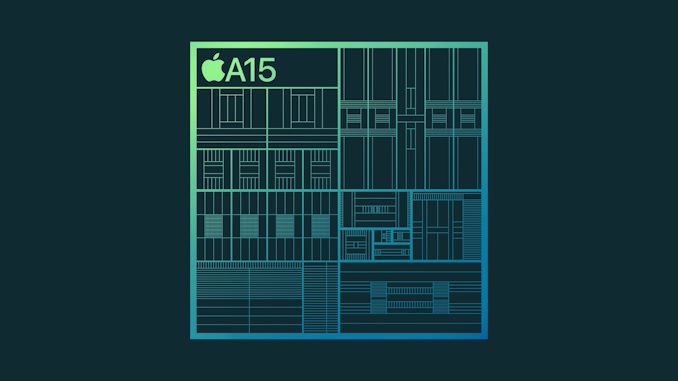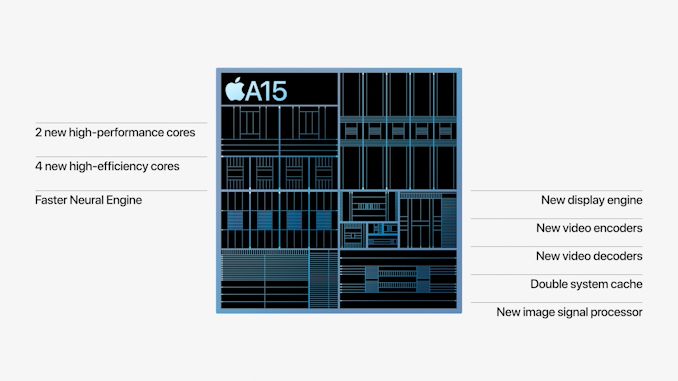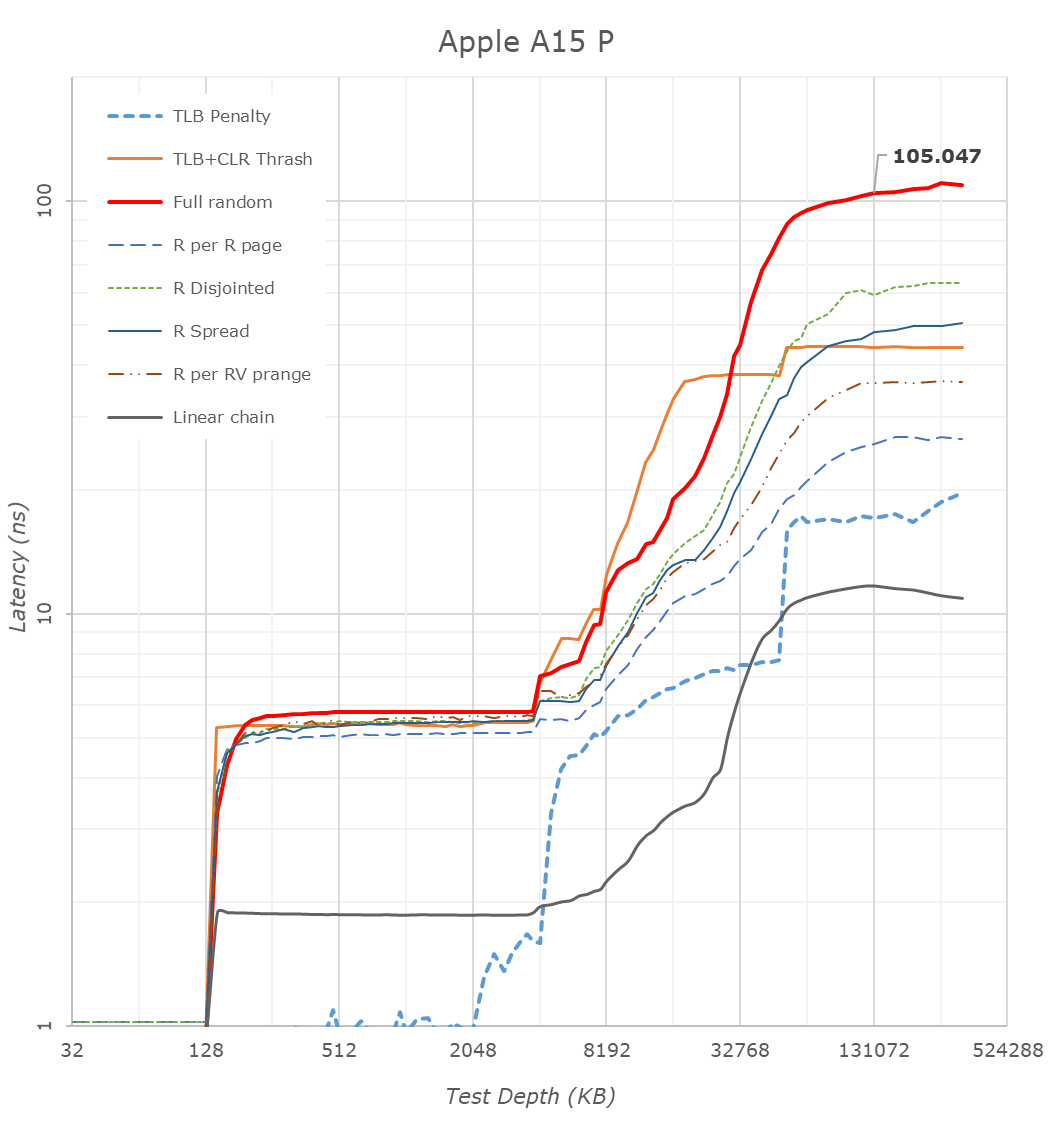The Apple A15 SoC Performance Review: Faster & More Efficient
by Andrei Frumusanu on October 4, 2021 9:30 AM EST- Posted in
- Mobile
- Apple
- Smartphones
- Apple A15

A few weeks ago, we’ve seen Apple announce their newest iPhone 13 series devices, a set of phones being powered by the newest Apple A15 SoC. Today, in advance of the full device review which we’ll cover in the near future, we’re taking a closer look at the new generation chipset, looking at what exactly Apple has changed in the new silicon, and whether it lives up to the hype.
This year’s announcement of the A15 was a bit odder on Apple’s PR side of things, notably because the company generally avoided making any generational comparisons between the new design to Apple’s own A14. Particularly notable was the fact that Apple preferred to describe the SoC in context of the competition; while that’s not unusual on the Mac side of things, it was something that this year stood out more than usual for the iPhone announcement.
The few concrete factoids about the A15 were that Apple is using new designs for their CPUs, a faster Neural engine, a new 4- or 5-core GPU depending on the iPhone variant, and a whole new display pipeline and media hardware block for video encoding and decoding, alongside new ISP improvements for camera quality advancements.
On the CPU side of things, improvements were very vague in that Apple quoted to be 50% faster than the competition, and the GPU performance metrics were also made in such a manner, describing the 4-core GPU A15 being +30% faster than the competition, and the 5-core variant being +50% faster. We’ve put the SoC through its initial paces, and in today’s article we’ll be focusing on the exact performance and efficiency metrics of the new chip.
Frequency Boosts; 3.24GHz Performance & 2.0GHz Efficiency Cores
Starting off with the CPU side of things, the new A15 is said to feature two new CPU microarchitectures, both for the performance cores as well as the efficiency cores. The first few reports about the performance of the new cores were focused around the frequencies, which we can now confirm in our measurements:
| Maximum Frequency vs Loaded Threads Per-Core Maximum MHz |
||||||
| Apple A15 | 1 | 2 | 3 | 4 | ||
| Performance 1 | 3240 | 3180 | ||||
| Performance 2 | 3180 | |||||
| Efficiency 1 | 2016 | 2016 | 2016 | 2016 | ||
| Efficiency 2 | 2016 | 2016 | 2016 | |||
| Efficiency 3 | 2016 | 2016 | ||||
| Efficiency 4 | 2016 | |||||
| Maximum Frequency vs Loaded Threads Per-Core Maximum MHz |
||||||
| Apple A14 | 1 | 2 | 3 | 4 | ||
| Performance 1 | 2998 | 2890 | ||||
| Performance 2 | 2890 | |||||
| Efficiency 1 | 1823 | 1823 | 1823 | 1823 | ||
| Efficiency 2 | 1823 | 1823 | 1823 | |||
| Efficiency 3 | 1823 | 1823 | ||||
| Efficiency 4 | 1823 | |||||
Compared to the A14, the new A15 increases the peak single-core frequency of the two-performance core cluster by 8%, now reaching up to 3240MHz compared to the 2998MHz of the previous generation. When both performance cores are active, their operating frequency actually goes up by 10%, both now running at an aggressive 3180MHz compared to the previous generation’s 2890MHz.
In general, Apple’s frequency increases here are quite aggressive given the fact that it’s quite hard to push this performance aspect of a design, especially when we’re not expecting major performance gains on the part of the new process node. The A15 should be made on an N5P node variant from TSMC, although neither company really discloses the exact details of the design. TSMC claims a +5% frequency increase over N5, so for Apple to have gone further beyond this would have indicated an increase in power consumption, something to keep in mind of when we dive deeper into the power characteristics of the CPUs.
The E-cores of the A15 are now able to clock up to 2016MHz, a 10.5% increase over the A14’s cores. The frequency here is independent of the performance cores, as in the number of threads in the cluster doesn’t affect the other cluster, or vice-versa. Apple has done some more interesting changes to the little cores this generation, which we’ll come to in a bit.
Giant Caches: Performance CPU L2 to 12MB, SLC to Massive 32MB
One more straightforward technical detail Apple revealed during its launch was that the A15 now features double the system cache compared to the A14. Two years ago we had detailed the A13’s new SLC which had grown from 8MB in the A12 to 16MB, a size that was also kept constant in the A14 generation. Apple claiming they’ve doubled this would consequently mean it’s 32MB now in the A15.
Looking at our latency tests on the new A15, we can indeed now confirm that the SLC has now doubled up to 32MB, further pushing the memory depth to reach DRAM. Apple’s SLC is likely to be a key factor in the power efficiency of the chip, being able to keep memory accesses on the same silicon rather than going out to slower, and more power inefficient DRAM. We’ve seen these types of last-level caches being employed by more SoC vendors, but at 32MB, the new A15 dwarfs the competition’s implementations, such as the 3MB SLC on the Snapdragon 888 or the estimated 6-8MB SLC on the Exynos 2100.
What Apple didn’t divulge, is also changes to the L2 cache of the performance cores, which has now grown by 50% from 8MB to 12MB. This was actually the same L2 size as on the Apple M1, only this time around it’s serving only two performance cores rather than four. The access latency appears to have risen from 16 cycles on the A14 to 18 cycles on the A15.
A 12MB L2 is again humongous, over double compared to the combined L3+L2 (4+1+3x0.5 = 6.5MB) of other designs such as the Snapdragon 888. It very much appears Apple has invested a lot of SRAM into this year’s SoC generation.
The efficiency cores this year don’t seem to have changed their cache sizes, remaining at 64KB L1D’s and 4MB shared L2’s, however we see Apple has increased the L2 TLB to 2048 entries, now covering up to 32MB, likely to facilitate better SLC access latencies. Interestingly, Apple this year now allows the efficiency cores to have faster DRAM access, with latencies now at around 130ns versus the +215ns on the A14, again something to keep in mind of in the next performance section of the article.
CPU Microarchitecture Changes: A Slow(er) Year?
This year’s CPU microarchitectures were a bit of a wildcard. Earlier this year, Arm had announced the new Armv9 ISA, predominantly defined by the new SVE2 SIMD instruction set, as well as the company’s new Cortex series CPU IP which employs the new architecture. Back in 2013, Apple was notorious for being the first on the market with an Armv8 CPU, the first 64-bit capable mobile design. Given that context, I had generally expected this year’s generation to introduce v9 as well, but however that doesn’t seem to be the case for the A15.
Microarchitecturally, the new performance cores on the A15 doesn’t seem to differ much from last year’s designs. I haven’t invested the time yet to look at every nook and cranny of the design, but at least the back-end of the processor is identical in throughput and latencies compared to the A14 performance cores.
The efficiency cores have had more changes, alongside some of the memory subsystem TLB changes, the new E-core now gains an extra integer ALU, bringing the total up to 4, up from the previous 3. The core for some time no longer could be called “little” by any means, and it seems to have grown even more this year, again, something we’ll showcase in the performance section.
The possible reason for Apple’s more moderate micro-architectural changes this year might be a storm of a few factors – Apple had notably lost their lead architect on the big performance cores, as well as parts of the design teams, to Nuvia back in 2019 (later acquired by Qualcomm earlier this year). The shift towards Armv9 might also imply some more work done on the design, and the pandemic situation might also have contributed to some non-ideal execution. We’ll have to examine next year’s A16 to really determine if Apple’s design cadence has slowed down, or whether this was merely just a slippage, or simply a lull before a much larger change in the next microarchitecture.
Of course, the tone here paints rather conservative improvement of the A15’s CPUs, which when looking at performance and efficiency, are anything but that.












204 Comments
View All Comments
name99 - Wednesday, October 6, 2021 - link
v8 based.Essentially ARMv8.5 minus BTI.
name99 - Wednesday, October 6, 2021 - link
https://community.arm.com/developer/ip-products/pr...lists what's new in 8.5
Wiki still says A15 is essentially 8.4, but A14 is generally described as above, eg
https://twitter.com/never_released/status/13610248...
On the other hand, no-one has seen evidence of MTE usage in iOS (either iOS14 or 15). Which may reflect non-presence, or that compiler support isn't yet there?
Mostly 8.5 is technical stuff that would be hard to test.
One possibility would be the random number instructions. Maybe we'll get clarification of these over the next month?
name99 - Wednesday, October 6, 2021 - link
We can see a little more detail here:https://github.com/llvm/llvm-project/blob/main/llv...
We see that, among other things, A14 added
- cache clean to deep persistence (basically instructions to support non-volatile-ram...)
- security stuff to invalidate predictions
- speculation barrier
- and a few other (uninteresting to me) 8.5 security features
Interestingly it also claims, on the performance side, to have added to A14 over A13, fusion of literal generation instructions, something I did not see when I tried to test for it -- presumably you have to get the order of the literal instructions correct, and I used the incorrect order in my quick tests?
Along with claims of a number of other instruction fusion patterns that I want to test at some point!
This was added in late Jan 2021, which suggests we won't see the equivalent for A15 until beginning of next year :-(
OreoCookie - Thursday, October 7, 2021 - link
My understanding is that ARM v9 essentially mandates parts of the ARM v8.x ISA that were optional and introduces SVE2. If I read your posts correctly (thanks for doing the checking, much appreciated), then it seems that Apple has implemented the “first half” of ARM v9 anyway and the only notable omission is SVE2.SVE2 sure sounds like a nice-to-have, but like you wrote the compiler will play a crucial role here. I reckon a proper implementation will eat up quite a bit of die area, and if you are not going to use it, what is the point?
RoyceTrentRolls - Wednesday, October 6, 2021 - link
Hear me out:A13 - 14 cycles 8MB 2 cores/big cluster
M1 - 16 cycles 12MB 4 cores
M1X/M2? - 18 cycles 16MB 8 cores
🤪
name99 - Wednesday, October 6, 2021 - link
It's a reasonable hypothesis BUT a big problem with cores sharing an L2 is that they all have to sit on the same frequency plane. (They can have different voltages, which matters if one of them is eg engaged in heavy NEON work, while another is doing light integer work; but they must share frequencies.)This may be considered less of a problem for the target machines?
Alternatively you just accept that life ain't perfect and provide two clusters of 4core+(?12?16MB L2)?
OreoCookie - Thursday, October 7, 2021 - link
With 2+4 core SoCs, I don’t think this is that big of an issue, though. Of course, it gets trickier once you scale up to more than 8 performance cores, but we will have to see what Apple’s solution is here anyway (8-core chiplets perhaps?).Overall, though, it seems that massively increasing caches is a common trend, AMD has been going in that direction (including their Zen 3 with additional cache slated for later this year) and IBM will be using massive caches on their new CPUs that will power their Z15 mainframes. The drawbacks are pretty clear, but the potential upside is, too.
mixmaxmix - Thursday, October 7, 2021 - link
battery life test result pleasemixmaxmix - Saturday, October 9, 2021 - link
pleaseRaqia - Thursday, October 7, 2021 - link
Die shot now available:https://semianalysis.com/apple-a15-die-shot-and-an...
More caches all around, and the GPU doubles the number of FP32 ALUs without adding much die area.